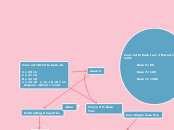week 2
Convert to Base Ten:
video
Subtracting in base five
If you are using base five notation to express numbers then the only symbols you have for digits are 0, 1, 2, 3, and 4. Thus 51 can't be a base five number.
you are always subtracting a smaller digit from a larger digit. The challenge is to deal with borrowing. Let's look at a base 10 problem first.
Starting in the first column 6 - 3 = 3 but in the next column you need to borrow from the third column. Since this is base ten notation you are borrowing ten so the 6 in the third column becomes 5 and adding ten to 3 you have thirteen in the second column.
subtraction
5 from 13 is 8 and 4 from 5 is 1 so the result is 183
Convert to base ten: 3 flats, 2 longs, 4 units
Base 5 = 89
Base 7 = 165
Base 11 = 389
Counting in base five
435
= 4 × 51 + 3 × 50
= 2310 ← (Convert from base 5 to base 10)
Convert 10112 to base 10.
1 x 20 = 1
1 x 21 = 2
0 x 22 = 0
1 x 23 = 8 1 + 2 + 0 + 8 = 11
Answer: 10112 = 1110
Adding in base five
base five is that the only digits you have are 0, 1, 2, 3 and 4. The other digits we work with, like 6 and 9 are just meaningless squiggles when working in base five. In what I am going to do I will only write digits 0, 1, 2, 3 and 4 except in one place. I will write a subscript of 5 on some numbers to remind us that we are working in base five but the subscript 5 is not part of the number. add 1325 and 4415.
132 + 441= add the units column. 2 + 1 = 3. Now add the second column. 3 plus 4 is seven. (Notice that I don't write the meaningless squiggle 7.) Seven is 125 so , just as in adding in base 10, I write down the 2 and carry the 1. Finally add the third column. 4 plus 1 is five plus the carry of 1 gives six. Six is 115 so I get 1325 + 4415 = 11235
